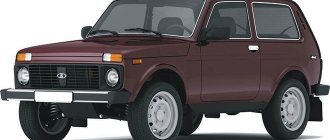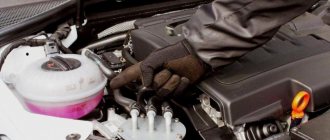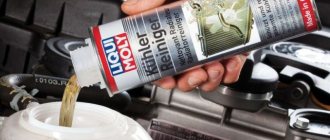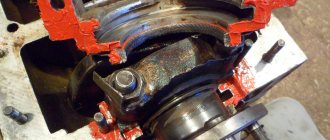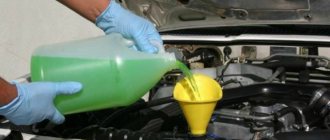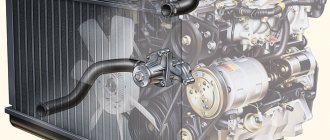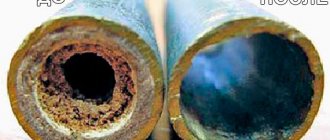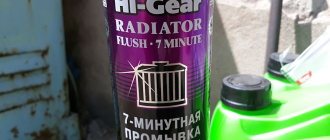The invention and use of antifreeze as a liquid for the car cooling system saved car owners from a number of quite serious problems. Firstly, antifreeze does not freeze when exposed to subzero temperatures, so it is safe to use in winter without worrying that undrained liquid after freezing will cause serious damage to the power plant. Secondly, the water contained a large amount of salts, which, after heating, settled as scale in the channels of the system, significantly reducing its performance.
What is the best way to flush the cooling system at a service station or do it yourself?
The first option is certainly simpler, but it is also more expensive, the second is less pleasant, but you will gain invaluable experience and also get good savings. If you are not short on time and have a little understanding of what SOD is, then I recommend flushing the cooling system yourself. Read on to find out how to do this.
Features and methods of flushing the cooling system
As I already said, unfortunately, the vast majority of car owners do not even know about the need to carry out such a procedure, perhaps you do the same - just add antifreeze to the level and that’s it. However, this will not always be the case, and at one unpleasant moment the cooling system will simply stop functioning, and you will get overheating with all the consequences... I recommend monitoring the condition of the antifreeze, and not adding it, but making a complete replacement, then during draining you will be able to see in what condition he is in. If you have drained the coolant and it is black or dark brown, you know that your cooling system has big problems.
How does the engine get clogged?
Many car owners are faced with the following situation: coolant that has just been poured into the engine gradually turns black. This is due to the fact that when filling, clean liquid passes through dirty radiator tubes, as a result of which it changes color and simultaneously clogs the remaining clean hoses and pipes of the engine. As a result, engine power drops to 10% and characteristic noise appears in the radiator.
At the same time, you need to understand that the radiator is contaminated not only by dust, but also by specific deposits. The composition and structure of these deposits depends on the coolant used by the driver. In 90% of cases the cooling system is flooded:
- Water. Moreover, some car enthusiasts still pour water directly into the radiator. During the summer months, this leads to the formation of scale on the pipes, which leads to clogging of the entire system. In winter, the water in the radiator turns into ice cubes, which renders the engine unusable.
- Antifreeze. Antifreeze effectively cools the engine (especially in winter), but after 1-2 months its gradual decomposition begins. Decomposition products enter the inside of the cooling system along with the liquid and clog the pipes.
How often to wash
Before we move on to a direct description of certain products, I would like to remind you how important it is to regularly flush the car’s cooling system. The fact is that, depending on the coolant used, rust, oil deposits, antifreeze decomposition products, and scale accumulate on the walls of the tubes that make up the radiator. All this leads to difficulty in coolant circulation and reduced heat transfer. And this always has a bad effect on the performance of the engine and increases the wear of its individual parts with the risk of their premature failure.
Dirty radiator
It is worth noting that flushing the system can be both internal and external (external cleaning involves flushing the radiator from the outside to remove particles of dirt, dust, and insects on its surface). It is recommended to do the internal flushing of the cooling system at least once a year . It is best to do this in the spring, when there is no longer frost, and a hot summer lies ahead.
On some cars, there is a light on the dashboard with a picture of a radiator, the glow of which may indicate not only a decrease in the antifreeze level, but also that it is time to change it. This may also serve as a signal that it is time to clean the cooling system. There are also a number of indirect signs of the need for such cleaning:
Radiator icon indicating problems with the cooling system
- frequent engine overheating;
- problems with the pump;
- slower response to rheostat signals (inertia);
- high temperature readings from the corresponding sensor;
- problems in the operation of the “stove”;
- The fan always runs at high speed.
If the engine gets very hot, then it’s time to select a product to flush the cooling system, and choose the time and opportunity for this.
There are two types of SOD purification:
External - when insects, dust, oily stains, dirt and other nasty things are removed from the surface of the radiator. Typically, this cleaning is done using a jet and car shampoo.
Dirty radiator - poor cooling
Internal - provides for the removal of deposits consisting of rust, scale, antifreeze decomposition products and rubber parts from the engine cooling jacket and radiator. In addition, contamination and scale are possible in cases where the car owner uses ordinary tap water as coolant. This should not be done under any circumstances, since such water contains a huge amount of salts, impurities and various substances, which, when heated, are deposited on the walls of the cooling system in the form of plaque, complicating heat transfer and reducing the cross-section of the SOD passages.
Cooling system VAZ 2106
When driving any car, including the VAZ 2106, in operating mode the engine heats up to 85–90˚С. The temperature is recorded by a sensor that transmits signals to the instrument panel. To prevent possible overheating of the power unit, a cooling system filled with coolant (coolant) is designed. Antifreeze (antifreeze) is used as coolant, which circulates through the internal channels of the cylinder block and cools it.
Purpose of the cooling system
Individual engine elements become quite hot during operation, and it becomes necessary to remove excess heat from them. In operating mode, a temperature of about 700–800 ˚C is created in the cylinder. If the heat is not forcibly removed, jamming of the rubbing elements, in particular the crankshaft, may occur. To do this, antifreeze circulates through the engine cooling jacket, the temperature of which decreases in the main radiator. This allows you to operate the engine almost continuously.
The cooling system is designed to remove excess heat from the engine and maintain operating temperature
Cooling system parameters
The main characteristics of the cooling system are the type and amount of coolant required for smooth engine operation, as well as the operating fluid pressure. According to the operating instructions, the cooling system of the VAZ 2106 is designed for 9.85 liters of antifreeze. Therefore, when replacing, you should purchase at least 10 liters of coolant.
Engine operation requires expansion of antifreeze in the cooling system. To normalize the pressure in the radiator cap, there are two valves operating for inlet and outlet. As the pressure increases, the exhaust valve opens and excess coolant enters the expansion tank. As the engine temperature decreases, the volume of antifreeze decreases, a vacuum is created, the intake valve opens and the coolant flows back into the radiator.
The radiator cap contains inlet and outlet valves that ensure normal operation of the cooling system.
This allows you to maintain normal coolant pressure in the system under any engine operating conditions.
Video: pressure in the cooling system
Methods for expelling air from the VAZ-2115 stove
If a motorist has diagnosed his car and realized that his VAZ-2115 heater is blown, he should use at least one of the methods below, which are considered quite effective solutions to the problem.
First method (blowing out the system)
According to the very first method, the motorist needs to dismantle the plastic casing covering the vehicle’s power unit. To remove this structural element, you will have to unscrew the cap covering the hole for adding oil. Then you need to remove the cover. It is worth noting that immediately after removing the protective casing, the cover should be returned to its place, which will preserve the cleanliness of the power unit by preventing the possibility of dirt and dust from entering.
The next step, which can solve the problem of airiness in the system, should be to search for the pipes responsible for warming up the throttle assembly. At this stage, it is necessary to pull off any pipe and, having twisted the lid from the hole in the container with antifreeze, cover the resulting “hole” with a clean rag.
To get rid of the malfunction, you will have to actively blow out the internal space of the tank. Through such actions, pressure is created, which pushes the collected air out. The need to stop the procedure should be indicated by the antifreeze coming from the pipe, since it will begin to come out only after there are no air accumulations left in the system.
After blowing out the VAZ-2115 system, the tube must be returned to its original place, and you should not hesitate, everything should be done as quickly as possible, otherwise a “portion” of unnecessary air will again appear in the tank.
Second method
If the VAZ-2115 stove is very airy, you can get rid of the resulting plug in just a few minutes without blowing out the system. To expel the accumulation of air, after actively warming up the power unit for 15 minutes, turn it off and, with the expansion tank cap closed, remove any pipe on the throttle assembly. After antifreeze or antifreeze starts coming out, you need to quickly insert the pipe into its original place. However, when using this method, one should not forget that after the power unit was running, the antifreeze could warm up to 80 °C.
Third method
The instructions described below will most likely help anyone whose VAZ-2115 stove is airy. To clean the system, you must first place the car at an angle; for this, a steep hill is suitable; the vehicle should stand with its nose at the highest point. After the car is put on the handbrake, and special stands are installed under all the wheels to protect the driver from unexpected rolling, you need to twist the plugs that close the holes on the radiator and expansion tank.
The power unit must be activated for at least 10 minutes so that it has time to warm up, then you need to press the accelerator pedal periodically, while adding coolant to the system.
Topping up antifreeze or antifreeze should be done until bubbles stop appearing. After they completely disappear, the work can be completed.
Flushing the cooling system on a VAZ car - step-by-step instructions, several methods
Any driver wants his car to serve for a long time and trouble-free, so it is imperative to periodically flush the engine cooling system. How can this be done for the VAZ 2114 and other models (2110, 2107, 2112)? High-quality performance of this work can only be guaranteed if certain rules are observed.
Sediment in the VAZ cooling system
Consequences of improper care of the cooling system
The cooling system (CO) is an important element of any car, especially if its engine is liquid cooled.
Its incorrect functioning can lead to irreparable consequences, and these are:
- Overheating of the engine, and as a result, its complete failure;
- Failure of the antifreeze heater or other similar device;
- Pump failure;
- Ineffective operation of the interior heater.
As a rule, the reason for the ineffective operation of the liquid cooling system of any car lies in contamination of the radiator, pipes, and cavities of the cooling jacket of the cylinder block.
If we could get inside this system, we would see an interesting picture.
Rust, scale deposits on the walls, residues from decomposed coolant, greasy oil stains and other troubles.
It is worth noting that we are talking about engines that have been in use for 2 years or more. We are not talking about new cars here.
Leaks and problems
Cars of this model sometimes have problems associated with the failure of some parts of the cooling system, such as a thermostat or pump. If they break down, they are replaced as an assembly, fortunately they are not expensive. Also, leaking hoses or a cracked expansion tank are considered a common problem, which also needs to be replaced.
But there is another problem with the VAZ 2106, a leaking heater valve. Because of this, there may be a smell of antifreeze in the cabin, wet floor mats on the front passenger side, or the heater may not work.
In cases of boiling or seething antifreeze in the expansion tank, you need to pay attention to 2 things. This is either an air lock or a broken cylinder block gasket. When determining the problem, in the first case the stove will blow cold. In the second case, there will be either oil in the antifreeze or light smoke from the exhaust pipe.
Why is flushing necessary?
Failure to flush the cooling system in a timely manner can lead to the radiator becoming clogged over time. Refrigerant wear products, corrosive residues, scale that appears as a result of using water instead of antifreeze - sooner or later this will contribute to a decrease in the performance of the radiator.
Failure of this element will result in problems with the operation of the engine, which, of course, will affect the functioning of the car as a whole. So flushing the engine cooling system is a process that should not be neglected, at least in order to protect your radiator. The procedure should be carried out at least once every two years, and the recommendations of the car manufacturer should be taken into account. By observing this frequency, you can prevent the formation of refrigerant wear and corrosion in the system.
Stove tap
Perhaps, in the “sixes”, and in all the classics, this is the most unreliable element. Unfortunately, the quality of this unit is good, but its design is such that it is impossible to operate this crane for a long time. Its function is to block the flow of hot liquid that enters the stove radiator. In many ways, it is only because of this tap that the cooling system of the VAZ-2106 breaks down. Malfunctions of this unit can be seen by several signs. The very first is the presence of antifreeze on the carpet near the passenger seat.
The failure of the tap is accompanied by the fact that it either does not open the supply of hot antifreeze or does not shut it off. In this case, by the way, the metal flag located on the faucet body will move. The reason for this behavior is the destruction of the ceramic plates with which the feed is adjusted. The owners go to all sorts of tricks - they turn off the liquid supply pipe for the summer, and install half-turn water taps, which can be purchased for pennies. True, it is necessary to make adapters to connect them.
When and why to flush
Solving this problem does not require special skills and knowledge, so you can flush the cooling system yourself. It is recommended to do this more often, but even if you perform cleaning once a year, you can achieve a positive effect.
Flushing allows you to avoid the occurrence of various malfunctions associated with the cooling system. The need for this procedure often arises due to the use of low-quality or expired antifreeze, which negatively affects the cooling unit of the car.
Scale in the VAZ cooling system
You can clean the cooling system less frequently if you adhere to the following rules for using antifreeze:
- When draining the coolant, you need to pay attention to its color, by which you can determine the degree of contamination of the system;
- instead of partially adding antifreeze, it is always better to completely replace it;
- The coolant must be renewed at least every two years.
When to change antifreeze
As a rule, antifreeze on a VAZ-2110 lasts for 150,000 miles. We strongly do not recommend exceeding this figure.
In practice, there are several reasons why early maintenance of a machine's cooling system will be required:
- The color of the liquid changed and became rusty.
- The surface of the tank was covered with an oil film.
- The car often boils, although there are no obvious reasons for this. As a rule, the VAZ-2110 is used quite intensively. Accordingly, boiling is far from uncommon. The fan may not work when driving at low speeds. Unusable antifreeze may boil.
- Coolant is leaking from somewhere. This is the most common problem on the vehicle in question. In this case, you need to carefully check all components of the system for leaks. There are cases when antifreeze leaves in ways unknown to the driver, and it is not visible where. Practice shows that the problem should be found in the clamps. Often, completely replacing these elements helps solve the problem.
To accurately determine the problem, check the level on a cold machine. If the engine does not boil, but gets quite hot, it can be very difficult to determine where the leak is. And leaks are impossible to notice due to high temperatures.
The fluid level is normal, the color has not changed, but the car is boiling. In this case, an air lock may form. Please note that when heated, the antifreeze level changes slightly
If you observe that the antifreeze is always going somewhere, it is important to identify the problem, because an ordinary replacement will not solve the problem.
How to flush the engine cooling system?
To get rid of limescale, use:
It is better not to consider “Cola” as a cleaner - it can destroy the internal walls of the radiator.
How to flush the engine cooling system with your own hands? “Home” preventive measures are best carried out every six months. Previously, during times of shortage, an acidified solution of low concentration was poured in (with acids available in everyday life). This is still done to this day, although professional means are now available to everyone.
If you do not clean regularly, forgetting to flush the engine cooling system (this is easy to do with your own hands), there is a possibility of the following problems occurring:
- pump blockage;
- the stove works intermittently;
- The distillation heater is not functioning.
Replacement frequency, what antifreeze to fill
According to the manufacturer's recommendation, it is necessary to replace antifreeze or antifreeze on VAZ 2106 cars every 2 years or after a mileage of 60 thousand kilometers. If the car is used in more severe conditions, then it is advisable to replace it more often - every 30-40 thousand kilometers.
In addition to the recommended coolant change intervals, there are other reasons why it is necessary to change the fluid in a car's cooling system:
- Loss of properties. You can check the quality of the antifreeze used using a test strip, which is sold in the same places where the liquid itself is sold. Place the strip in the expansion tank, then pull it out. The strip comes with a color scale, according to which you can understand how much longer the car can be used before replacing the coolant.
- Change in color to red or red. This means that rust has appeared in the composition.
- The appearance of sediments, flakes and dense formations.
In all cases, it is necessary not only to replace, but also to check the entire engine cooling system for serviceability.
As a coolant for the VAZ 2106, you can use good Lukoil antifreeze. Or a lesser-known but high-quality product from Gazprom Neft. When replacing, you can also fill in antifreeze, preferably with G12 approval, it is safer for the entire system. You can also use original Lada G12 antifreeze, which is suitable for all cars of this manufacturer.
How much antifreeze is in the cooling system, volume table
Products for home use
With proper care and preventive maintenance, cleaning the cooling system is not difficult. Before starting the procedure, you need to prepare it:
The engine is cooled if it was running before.- Place a container for old antifreeze under the drain.
- Unscrew the plugs from the bottom of the radiator and cylinders.
- Wait until the liquid is completely drained from the system.
- The drain plugs are screwed back in.
- Fill the expansion tank with cleaner.
Distilled water
If over the past years the car has been kept in order and preventive washes have been carried out, then the use of distilled water is considered sufficient.
It is poured into an empty expansion tank . The amount of distillate must correspond to the volume of the container. After this, start the engine for 10-25 minutes.
For best results, it is recommended to take a test ride. After turning off the car, allow time for cooling and drain the water from the tank.
If the poured distillate contains flakes or rusty sediment, then repeat the cleaning. When the poured water shows that there are no impurities, fresh coolant is added.
Lemon acid
This product helps to cope with a small degree of contamination. To prepare the working solution, citric acid is dissolved in water .
The standard proportion is 30-40 g per 1 liter. To enhance the effect, prepare a more concentrated solution, increasing the dose of powder to 80-100 g. The optimal pH value of the lemon reagent is 3.
After the cleaner is poured into the tank, turn on the engine and warm it up for 15-25 minutes. Leave the reagent in the system for 5-12 hours. When draining the solution, visually check the degree of contamination . If necessary, the cleaning procedure is duplicated.
You can learn more about the use of citric acid in the fight against rust here.
The video will show you how to flush the cooling system with citric acid:
Vinegar
For washing, use vinegar with a concentration of 9% . For 5 liters of water you need a glass of acid (250 ml). This cleaner is used by analogy with citric acid.
The acetic reagent is poured into a container from which the antifreeze has previously been drained. Fill the tank with the prepared solution, start the engine for 20-30 minutes. The acetic liquid is drained after 8-12 hours. Flush the system with distillate and fill it with new refrigerant.
You can learn more about the use of vinegar in the fight against rust in this article.
Milk serum
For work, use store-bought or homemade serum . In the latter case, the liquid must be filtered through several layers of gauze so that no curdled inclusions remain in it. The serum should not be diluted with water before use.
Pour liquid into the system, start the engine for 30-40 minutes and do a test run, preferably without stopping. To remove traces of the serum after it has been drained, the tank is filled with distilled water and the car is started again.
Soda
The washing solution is prepared from soda ash (8-10%) and caustic (3%) soda.
The powder is diluted with water, its amount in the solution should be 85-90% . After filling the tank with soda reagent, the car is driven 50-100 km. Then the cleaner is drained and the distillate is passed through several times.
The soda solution should not be left in the cooling system for a long time. The maximum time is a day.
Cola
The drink contains orthophosphoric acid, which dissolves salt and rust deposits. However, the method is considered not the safest, since acid has a negative effect on rubber pipes, and sugar has a negative effect on metal surfaces.
If the choice is still made on this purifier, then carbon dioxide is first removed from the drink. After filling, the engine is left in working condition for a maximum of 15-20 minutes. After removing the Coca-Cola, the system is cleaned with distilled water. Read more about using Coca-Cola against rust here.
Special formulations
Ready-made chemical cleaners are divided into four groups:
- neutral,
- acidic,
- alkaline,
- combined.
To select a suitable liquid, it is necessary to determine the degree of contamination of the cooling structure and the type of deposits.
For preventive treatment, neutral compounds are purchased. Acid products are suitable for removing inorganic impurities. Organics are removed using alkalis. Two-component ones are used as universal remedies for all types of pollution.
Our range of effective chemical washes includes:
- LAVR. Russian-made foam decarbonizer is intended for trucks and passenger cars. For rinsing purposes, first fill in liquid from bottle No. 1 and water. Start the engine for a quarter of an hour. Drain the first reagent and fill in liquid from bottle No. 2, adding water. Leave the car again with the engine running for 15-20 minutes. Flush the system with distillate two or three times. A set consisting of two bottles costs an average of 500 rubles.
Hi-Gear Radiator Flush .
Product manufactured in the USA. Suitable for passenger cars. There are no acids in the formula, so the cleaner is safe for rubber elements. The product is poured into the tank with a cold engine, after mixing the entire volume of the bottle with 4-5 liters of water. Start the engine for 7 minutes at a speed of 1500–2500 rpm.Then wait until the engine cools down, drain the chemical and wash it with distillate. The average price of a bottle is 350 rubles.
- LIQUI MOLY Kuhler-Reiniger . A German remedy classified as neutral. Ideal for cleaning rust, oils, emulsions. The reagent is added to the coolant at the rate of 300 ml per 10 liters of refrigerant. Start the car and keep it idling for up to half an hour. After switching off, if necessary, leave for another 3 hours. Then the contents are drained and washed with distillate. A bottle sells for an average of 460 rubles.
Simple cleaning products
Almost every owner has distilled water available. It is quite suitable for cleaning the system from simple contaminants. The water washing process is carried out in the following order:
- Drain the coolant and fill the system with water.
- Start the engine, which should run for 30 minutes.
- Drain remaining water.
These steps must be repeated until the water is clear when drained. This method will not help get rid of contaminants such as scale or rust.
You can also use lactic acid, caustic soda or vinegar to flush the cooling system. These products need to be mixed with distilled water, and then the same steps described above are performed. There should not be too much acid, otherwise such a solution can damage the rubber and plastic elements of the car. At the end of the procedure, you need to fill in clean distilled water, which is necessary to clean the system of residual solution.
Why does the radiator get dirty?
The reason for external contamination of the radiator is obvious: dirt gets on it directly from the road. The device is located in the engine compartment and does not have special protection. In the best case, a small shield can be installed under the radiator to prevent large stones and debris from getting into the fins of the device.
There are two reasons for internal pollution:
- dirt enters the cooling system from the outside. If there are cracks in the radiator hoses or in the radiator itself and the tightness of the system is broken, then its clogging is only a matter of time;
- The radiator becomes dirty due to poor antifreeze. It's no secret that finding high-quality antifreeze today is not so easy. The market is literally flooded with fakes. Antifreeze from well-known brands is especially often counterfeited.
Both dirty and fake antifreeze contain many foreign impurities. The radiator becomes very hot during operation. Sometimes antifreeze can even boil, and the impurities it contains form scale, which impedes the circulation of the coolant. Which leads to overheating of the motor.
How to wash the outside of a car radiator
The cooling radiator is actively used. During operation, it becomes clogged with dirt and debris. Then the heat does not completely escape into the environment, but flows back to the engine. As a result, the motor overheats. The radiator must be cleaned regularly to keep the vehicle in good working order. To clean the outside of the unit, you can use ordinary water. If there is persistent contamination, then water alone will not be enough. Then it is better to take a special substance to clean the outside of the car radiator. There are many universal products on sale that are good at cleaning dirt from the unit. The cost of such substances varies. It depends on the composition and manufacturer.
Auto chemicals contain concentrated components that quickly remove salt deposits, rust, oil stains, and dirt. For external cleaning you will need buckets, brushes, work gloves, rags, and cleaning agent. To wash the outside of the radiator, you must first remove it from under the hood. You can perform the procedure using soapy water and a brush. This is the easiest way to clean the radiator externally. After soaping the knot, it is washed with warm water.
How to flush a cooling radiator
Manufacturers produce effective products for flushing the radiator from the outside. The following substances have good reviews:
- Liqui Moly Kuhler Reiniger. An excellent product for removing scale, dirt with grease particles and chemical compounds.
- Hi-Gear. Designed for old dirt and rust.
- Mannol - External cleaning of the unit removes rust, scale and other deposits.
If external cleaning does not bring results, you will need to perform internal flushing. If there is serious damage, the unit will need to be replaced. In many cases, mechanical cleansing is successfully carried out independently. This solves the problem of overheating. At the same time, they inspect the pipes and hoses, change the radiator cap and thermostat.
Products used – auto chemicals
The advantage of cooling system flushing products is that they keep up with the times.
Their composition is developed in such a way as not to harm the engine. For example, for copper radiators they used to use some means, now for aluminum they use others. Or combined for all types of engines.
They are inexpensive, so almost every car owner can afford to buy such a product.
Radiator Flush.
It removes the most difficult contaminants from the cooling system quite well. A 250 ml bottle is enough to rinse a small car with CO three times or a car with a large engine capacity twice.
Characteristics of Radiator Flush.
Application.
LAVR Radiator Flush 1&2.
Another good tool for cleaning the cooling system. Popular for its good value for money.
This is a washing complex, which includes two compositions.
First cast
. Fights rust and scale. It removes them well and removes them from the system.
Second cast
. Eliminates oil deposits and dissolves fats.
The complex is neutral to rubber products, plastic and all types of metals.
Application of LAVR Radiator Flush 1&2.
Don’t forget, at the final stage, rinse with distilled or boiled water.
There are many other similar cleaning products, but before using them, read the reviews on the forms.
Compressor or turbine for the “six”
Cooling system diagram for a VAZ-2112 16 valve injector
You can increase engine power by installing a compressor or turbine, but first you need to figure out what is required for this. First of all, you need to understand that, due to its design features, it is possible to install a turbine on a carburetor engine, but it is quite problematic. The nuances include both large material and time costs. The most important points to think about when equipping a car with a turbine are:
- Mandatory installation of an intercooler. This part is a kind of radiator, only the air is cooled in it. Since the turbine creates high pressure and the air is heated, it must be cooled to obtain the effect of the installation. If you don't use an intercooler, there will be an effect, but much less.
- Equipping a carburetor engine with a turbine is a dangerous undertaking. According to the experience of car owners who carry out such modifications, the exhaust manifold may “bang” and the hood will fly off. Since the intake principle on an injection engine is different, a turbine for this engine is a more preferable option, albeit an expensive one.
- Based on the second point, the third follows - it will be necessary to convert the engine into an injection one or install one.
Installing a turbocharger on a car requires large financial investments.
If you are not such an avid racing driver, then you should look towards the compressor, which has the following differences from the turbine:
- Does not develop high blood pressure.
- There is no need to install an intercooler.
- You can equip a VAZ carburetor engine.
To equip a VAZ 2106 with the unit in question, you will need a compressor kit - a kit that includes everything necessary for converting the engine (pipes, fasteners, supercharger, etc.).
The compressor kit for the “classic” consists of a supercharger and the necessary components for installation
The product is installed according to the manufacturer's instructions.
Can I wash it with bleach?
It should be borne in mind that one of the components of this solution is sodium hypochlorite, which can corrode aluminum. Moreover, the higher the temperature of the bleach rises, the faster the corrosion process occurs.
When choosing what to flush the cooling system with, you should approach this issue thoughtfully. If you choose the wrong cooling system cleaner, it can quickly cause the radiator to become clogged or fail.
After the cleaning procedure, it is recommended to install an engine cooling system filter to prevent blockages. If you are not sure that you can clean the radiator yourself, it is better to contact a car repair shop.
Special liquids for flushing the radiator
The means listed above, of course, can be used to flush the radiator and cooling system of a car, but they have already become obsolete both morally and technologically. Currently, auto chemical manufacturers offer consumers a wide range of different cleaning products that cost quite reasonable money, that is, affordable to the average car owner.
Types of liquids
There are several types of cleaning fluids for radiators, which are divided by chemical composition. In particular:
Popular liquids
We present for you an overview of the most popular liquids in our country for flushing a car’s cooling system, as well as some reviews from car enthusiasts who have used this or that liquid. We hope that the information below will be useful to you, and you will know the best way to flush your cooling system.
